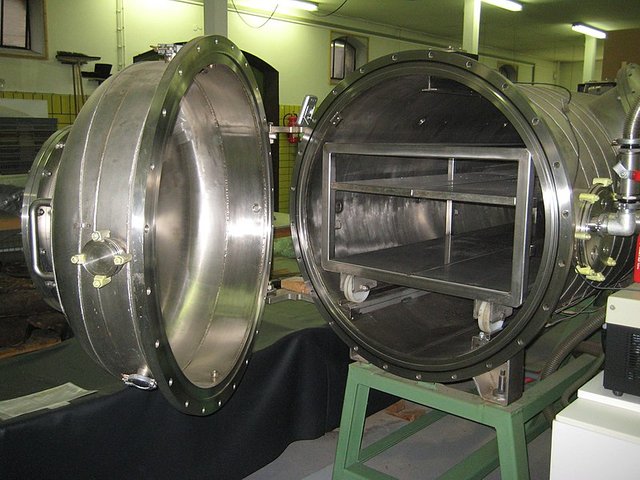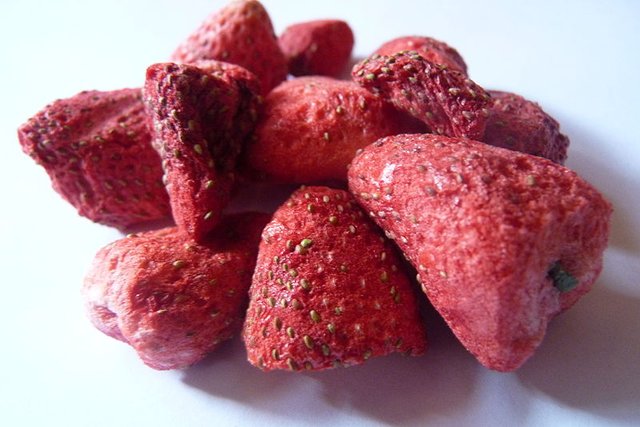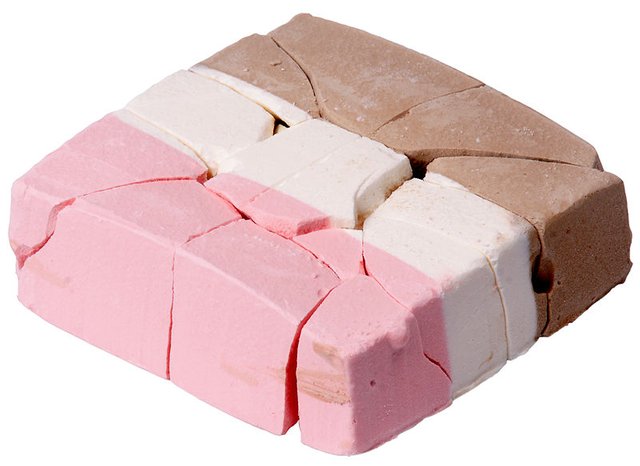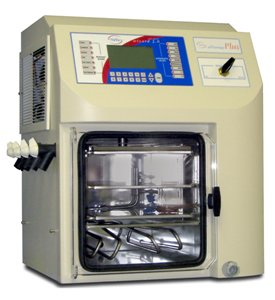FREEZE DRYING : A drying method that keeps your nutrients intact.
It originally appeared to me as people's opinion, then it began meaning more than just that, evidences prove it to be true : The belief that you can't have it all with Science. That when Science provides a new way to solve a problem, it usually comes with another side effect. Of course, the word side effect is something very synonymous with drugs that are meant to improve our health.
You probably heard of the recent discoveries about the flight data from the Apollo flight to the moon. It was revealed that the landing on the moon - which of course is a great milestone for human technological development that can never be forgotten - had a negative effect on the moon's surface.
Also, if you've been reading @addempsea's blog, you would have noticed that he has recently been discussing some medical imaging technologies, you probably noticed that towards the end, he usually mentions some dangers associated with them. An example is X-ray, where too much exposure can actually cause a problem bigger than what brought the patient to the hospital in the first place.
Before you remind me to clean my house before complaining about another man's dirty compound, I've decided to do so. I've recently discussed drying methods in agriculture. The purposes of agriculture are of course to either provide food for eventual consumption or raw materials for further production among others, unless you're among those that just do it for the pleasure, assuming such farmers exist.
However, I remember very well that one of the things I learnt as a secondary school student of economics is Utility. Even though I'm not an expert in the field of economics, further classes in Agricultural economics taught me that it comes to play in how much your products appeal to the consumers. This can be in the case of quality on offer, maybe with their colour or the nutrients in the products. Let me expatiate a little.
Imagine that, you want to buy tomato or strawberry at the market, and you can't find the characteristic red colour, how appealing will they be to you, and how much will you be willing to pay? What if the colour isn't even green, instead it has turned brown from drying, and you're imagining how brown your soup will look no matter the amount of palm oil you add?
Let's say the colour is intact, but you got to know that most of those that consume that particular product are always falling sick from the deficiency of essential nutrients that the crops were supposed to give you in the first place, how motivated will you be to buy them?
Yes, drying is meant to preserve the products so that we can have them everytime want them, but at times, many of these drying processes can at the end of drying give us products that have lost a meaningful part of their appearance (colour or shape) and more importantly nutrients, such that a larger part of their appeal is lost in the process. The case of the nutrients is why we carry out Proximate analysis at the end of drying (with different methods) to know how much is lost in nutrients. But then, because the nutrient levels remain within the acceptable range, the methods still continue to serve us. But maybe not too well.
What if you know of a method of drying where you don't have to lose the colour or the nutrients in your product, yet successfully dry them for preservation, maybe for even longer shelf lives? Well, you're in luck, as I'll be explaining one such method to you today.
You probably know it by one of its two common names : Lyophilisation or Freeze-drying. I'm more familiar with the latter, so permit me to predominantly use it henceforth. Now to the business of the day.
Maybe you've already guessed by the name that it's a kind of drying that involves freezing, well you're not exactly wrong, only you won't be getting a national medal for that guess, and before you attempt to find another definition, just leave it to the professionals. Like this dictionary for example
to subject (food, vaccines, etc.) to quick-freezing followed by drying under high vacuum at a low temperature
Collins Dictionary.
I know you may have your questions, like why freeze something you want to dry?, isn't drying supposed to be done at a raised temperature?. The answer to these questions are conveyed by one of the earliest topics you were taught in Science : states of matter. I'll mention them again just for the sake of those of us that are now too busy to remember, Liquid, Solid and Gas. While discussing these, if you still remember, you were taught a phenomenon caled Sublimation, the understanding of this is key to getting the hang of Freeze-drying.
Under normal atmospheric conditions, a substance is supposed to follow a particular order when transitioning between these states. For example, if it is a solid, application of heat is first supposed to transform it into a liquid and from that, a further heat application transforms it into the gaseous state. However, if these atmospheric conditions were purposely altered, a substance can be made to transform directly from a solid into a gas without visiting the liquid state, when this occurs, the process is called Sublimation.
Freeze-drying is used in the drying of various vegetables, fruits (e.g strawberry) and beverages (coffee), food (e. g meat, ice-cream). It is also used in the pharmaceutical industry for preservation of drugs.
Sublimation's role in Freeze-drying
Now to be honest, as a secondary school student, I never really understood where the whole sublimation idea comes into play, or where it really impacts scientific processes. Well, if you ever felt the same, you're about to love it.
Remember that the problem with most drying methods, especially the part where they lose nutrients is due to the application of heat at high temperatures to remove moisture, which leads to the breaking down of certain bonds in the products, thus leading to loss of important nutrients. So, there arose a need to dry products at a temperature low enough to ensure that the chemical composition of the product remains intact, and it was out of this need, that the idea of Freeze-drying was borne.
Now to answer why you need to freeze before drying. When harvested, your products contain moisture, and this moisture is in the liquid form. To remove this moisture directly, will mean a liquid to gas conversion, and to do this, heat and high temperature will be needed, which defeats our whole reason for using this method, right? Not to worry, though, it is for this reason that the product is first frozen, such that the moisture becomes solid and it can then be sublimed into the gaseous state.
Yes, I know you want to remind me that it will take even more heat to convert the solid moisture into the gaseous state than it would have taken if we left it at the liquid state. Or that you've tried thawing at home previously, and the solid ice usually turns into liquid before vaporizing. Under normal atmospheric conditions, you're very right. But to understand the reason for this freezing, let me introduce you to a friend - Triple point.
Here is what a dictionary says about Triple point
the particular temperature and pressure at which the solid, liquid, and gaseous phases of a given substance are all at equilibrium with one another.
Dictionary.com.
Now, here's a good thing about our new friend, if you could informedly tweak these conditions, you can skip a phase. Here is what I mean. The triple point of water occurs at these conditions :
Temperature of 273.16 K (0.01 °C; 32.02 °F) and partial vapor pressure of 611.657 pascals (6.11657 mbar; 0.00603659 atm). However, and this is where it gets interesting, the pressure up there is the lowest at which water can exist in the liquid phase. Of course when you thaw in your kitchen, you do so at a pressure above this point, hence, the transitioning from solid to liquid before vaporization.
But, should you do so at a pressure below that triple point and you can manage to keep the pressure constant while applying the heat, you will have your solid ice becoming vaporized without visiting the liquid state at all, or in other words, your ice sublimes. And just like that, you've eliminated moisture from your product.
It is noteworthy that since the pressure has been taken below the triple point, the heat supplied for the drying is very minimal, just enough to sublime the solid ice and at such keeping the chemical composition of the products and in turn their nutrients intact. This is the ultimate advantage of Freeze-drying.
In summary, Freeze-drying involves freezing the product, reducing the pressure below triple point and then subliming the ice.
Now, that we've understood the basic idea behind Freeze-drying, let's go a bit deeper by explaining the steps that are involved in doing it, and it that process gain a better understanding of the process.
Here are the stages
Depending on who you ask, you'll either be told there are three or four steps in Freeze-drying. Usually, those that tell you the former are actually leaving out an original step that the latter party feel is still an important step. So, I suppose I should just explain all four. These four steps are Pre-treatment, Freezing, Primary Drying and Secondary Drying.
Pre-treatment : To ensure that the food products or drugs are properly dried, some processes are carried out on them before the Freeze-drying process is started at all. At times their concentration is increased (in the case of drugs) or substances to ensure fluidity in case of some food substances. Any process done at this stage is referred to as Pre-treatment. You may then understand why some feel it isn't really part of Freeze-drying.
Freezing : At this stage, you truly commence the process by using a high performance refrigerator and ensuring that the product is completely frozen. This is because at the end of Freeze-drying, after you've stored the product till the point when you're ready to consume it, there is what we call reconstitution, which simply means adding water to the product so that you can have the product in its original state. How quickly this reconstitution occurs depends on how well you froze the product at this initial stage. How long it takes you to fully dry the product is also dependent on proper freezing.
However, to enable faster sublimation of the ice, research has shown that the freezing process should produce large ice crystals, but because this does not readily occur during freezing, there may be need to carry out the freezing slowly and in temperature cycles in a process called Annealing.
- Primary Drying : Most of what is referred to as Freeze-drying occurs here. The idea of subliming the solid ice is what is practiced here. As mentioned earlier, there is need to lower the pressure below the triple point of water. This is why there is usually the need for a vacuum to create the required low pressures. Also, the low heat usually gets to the products through conduction and radiation.
It is important to mention that, most of the water present in the products are removed at this stage, and by most I mean as much as 95% of the water content. Also, whatever organic solvents that constitute the remaining moisture in the product leaves at this stage. But, drying can't stop here, because the remaining 5% or thereabout of water remaining in the product is enough to trigger deterioration and spoilage. To address that, we have the final stage.
- Secondary Drying : The principle that necessitated this final stage is adsorption of water molecules. Remember that primary drying removes the ice by sublimation, but that won't work when it comes to removing adsorbed water. We will have to employ desorption, and this will require that the temperature be raised a little above what we had in primary drying (probably above 303K). By the time this process is concluded, very minimal water content is left in the product, as low as 1%.
What will you find in a Freeze-dryer?
Should we attempt to discuss all types of Freeze-dryers available, you certainly won't finish reading this article today. Good news is, they all have essential parts in common, and we shall briefly discuss those.
Types of Freeze-dryers include Chamber type, Shelf type, Pilot type and many more depending on purpose and appearance.
Generally, you will have your chambers, which either consists of shelves or flasks, depending on the type of Freeze-dryer you're using. It is where the main Freeze-drying takes place, at times other components like condensers are incorporated in this chamber.

Freeze-drying equipment with vacuum at a Museum from Wikimedia under CC-BY-SA 4.0 International license by Nightflyer
You will also need the refrigeration system which is responsible for the freezing of your products, and as earlier mentioned, high performance units are preferable as these ensure proper and complete freezing. Working closely with this is the condenser which does the work of extracting your water vapours from the chamber and turning them back into ice.
A great hero among them is the Vacuum pump which does the job of creating the required pressure conditions without which freze-drying would be impossible. Also, we have the Control systems which monitor and regulate the temperature and pressure conditions in the chamber during the whole process to ensure that all is well.
Freeze-dried products are kept in airtight containers until they are needed.
The very significant ability of Freeze-drying to keep the nutrients inside agricultural products intact, with the most minimal loss if any, and also endure longer shelf life are the main reasons it has become widely used in industries today. In fact, astronauts usually have Freeze-dried foods handy.
Here is another edge that it has over all other drying methods, the material can be fully reconstited upon rehydration. This isn't something that can be obtained from other drying methods because, the hear would have altered a lot in the composition of the products dried under such methods.
Now that is not to say that some will not find one reason or the other to say that our dear Freeze-drying isn't a saint after all. They might point to the fact that it is not a cheap drying method, and that wouldn't be a lie, home units can cost above $1,500. Also, because drying is done at very low temperatures, some microbes that thrive under these conditions, if not properly eliminated can destroy the products eventually.
Obviously, the unique advantages greatly outweigh whatever it is that appears to be downside. Also, with continued research, it is obvious that the prices of home units will become more affordable, enabling you and I to fully enjoy the goodness of the Freeze-drying process.
So, yes, you can sometimes have it all with Science. Until we cross paths again, please keep breathing.
REFERENCES
Fellows, P. (Peter), (2017). "Freeze drying and freeze concentration". Food processing technology : principles and practice (4th ed.). Kent: Woodhead Publishing/Elsevier Science. pp. 929–940. ISBN 0081005237. OCLC 960758611
J. Jeff Schwegman (2009) "Basic Cycle Development Techniques for Lyophilized Products"
Ratti, Cristina (2008-11-21). Advances in Food Dehydration. CRC Press. pp. 209–235. ISBN 9781420052534.
If you write STEM (Science, Technology, Engineering, and Mathematics) related posts, consider joining #steemSTEM on discord here. If from Nigeria, there may be need to include the #stemng tag in your post. You can visit this blog by @stemng for more details. You can also check this blog post by @steemstem here and this guidelines here for help on how to be a member of @steemstem. Please also check this blog post from @steemstem on proper use of images devoid of copyright issues here
Would you like to delegate to the @steemstem? Here is a link below
50 SP | 100SP | 500SP | 1,000SP | 5,000SP | 10,000SP | 50,000SP




This is a good lowdown on what freeze drying entails. Why freeze dry when you can just freeze?
Power is the reason, you need to maintain the conditions to ensure freezing, and that means continuous power consumption, but just Freeze-dry and keep in an airtight container and you're good to go.
And yes, there is
flash drying, just you wait. You'll get the full package.Oh, I get now. Thanks
I am familar with the triple point during my secondary school days, but heating below this point to convert solid to gas directly, wow that is new to me and ofcourse brilliant. Its a pleasure coming here
Hello! I find your post valuable for the wafrica community! Thanks for the great post! @wafrica is now following you! ALWAYs follow @wafrica and use the wafrica tag!
This is just great, its the first time I am reading about freeze drying.
But i have few questions,
Is it until you need the product that's when you stop freezing it?
How long does the process take!?
Also how durable would these products be after freeze drying?
The freezing is part of the drying process actually, and once your drying is done, it can stay that way for a very long time, like I said, astronauts take advantage of such dried products.
The Freeze-drying process can take days even in industries.
Hmm... Sounds like something i want to try so bad 😂😂
If only we'd been taught chemistry and its application this way, we'd have been bosses ourselves. Nice breakdown bro.
Lemme join the SBD joke. Can we freeze-dry once it moons?!
We were never really taught the applications, just someone expecting us to cram the theories and pour them during tests and exams, and boy we were good at that 😁
As to the SBD, please freeze away, you can always reconstitute when you want.
Hahaha. Nice one bro.
XoXo
Wow, when you told me I have to sit down to read post and understand how things are being done on steemstem, I never knew it was that important. I can see what you meant when you said that the other day. This your article is far from boring.
At least, I know fruits, meats and medicines can be freeze-dried and the nutrients in them will still be intact unlike the sun-dried ones.
The concept of freeze-drying thoroughly explained. So good to have known various ways it can be applied. An educating one this is. Good job well-done
Hi @sogless!
Your post was upvoted by utopian.io in cooperation with steemstem - supporting knowledge, innovation and technological advancement on the Steem Blockchain.
Contribute to Open Source with utopian.io
Learn how to contribute on our website and join the new open source economy.
Want to chat? Join the Utopian Community on Discord https://discord.gg/h52nFrV
The concept of sublimation just made sense to me all thanks to your article. and you presented it in a very succinct manner. freeze drying products really helps to preserve the nutrients, taste and color to make it nice when consumed.
How i wish we could have freeze dried SBD in december.
Not only you Mehn.
If you asked me as a secondary school student, I would have told you sublimation was an idea someone just made up to amuse himself because I never really saw where it fit in, but I've come to learn that was because of the way we were taught. Sublimation is a very interesting and useful phenomenon.
Please let the SBD moon again, then we shall Freeze-dry. 😁😁
finally understand sublimation after all this while